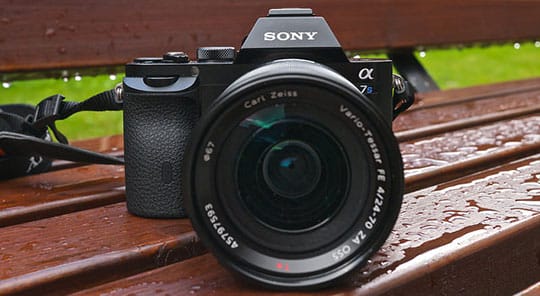With the advent of HDTV and megapixel cameras, modern security systems can definitely provide images with ultra-high-resolution. When it comes to the quality of these high-resolution images, many components are necessary to achieve crystal-like clarity. Camera iris is one such component which is required to produce lucid images and videos.
What is an Iris?
It is an element, which is used to control the intensity of illumination being fed into the lens. It consists of a number of thin plates that are arranged in such a way that they create a circular opening in the center. This opening is also known as aperture.
The intensity of illumination is controlled by adjusting the width of this opening. If the aperture creates a wider opening, then more light can get through it, and if the aperture creates a smaller opening, it allows less light to pass through it. The light after passing through this opening strike on the image sensor and then it is converted into electrical pulses, and the video is created.
Why is it needed?
The intensity of illumination can make or break the quality standards of video footage. If there is too much light striking on the image sensor, then it will wash out the video, and if there is too little light, then there will be a complete blackout in the final image. So it becomes critical to have just the right intensity of illumination feeding into the camera. An iris does just that. Based on location, it will maintain the optimum illumination to produce a sharp and correctly exposed image which also features better resolution and contrast.
You may also like: Top 10 Best Selling Digital Camera Lenses (DSLR Lenses).
What are the different options?
Unlike the old days, today the advanced video monitoring equipment comes with various types of aperture controls like fixed, manual, auto and P-iris. Each of these four types differs a bit in its working. You can always choose the one that suits your purpose.

Let’s get an understanding of different types of iris control.
1. Fixed Iris
 The opening or the aperture remains at a preset position and cannot be adjusted. It is most suitable for indoor applications where the intensity of illumination is constant throughout the length of the day. In particular, schools and offices can make use of fixed aperture, as these places usually have many overhead lights that provide constant illumination.
The opening or the aperture remains at a preset position and cannot be adjusted. It is most suitable for indoor applications where the intensity of illumination is constant throughout the length of the day. In particular, schools and offices can make use of fixed aperture, as these places usually have many overhead lights that provide constant illumination.
2. Manual Iris
 The opening of the iris can be controlled with the help of a knob or a ring to allow more or less light to strike on the image sensor. This adjustment is done during the installation process as it can get a little tricky if the video devices are installed in hard-to-reach places. Moreover, this aperture control is less popular for outdoors as the lighting conditions change much more rapidly as compared to indoors.
The opening of the iris can be controlled with the help of a knob or a ring to allow more or less light to strike on the image sensor. This adjustment is done during the installation process as it can get a little tricky if the video devices are installed in hard-to-reach places. Moreover, this aperture control is less popular for outdoors as the lighting conditions change much more rapidly as compared to indoors.
3. Auto Iris
 Cameras with auto-iris can automatically tune the opening in accordance with the lighting level and illumination intensity. This adjustment is achieved through a motorized control. As this aperture incorporates advanced technology, it is slightly expensive as compared to its fixed and manual counterparts. It is further divided into two types: DC Iris and Video iris. Both of these aperture types use analog signals and motor-driven mechanisms to control the iris opening. The only difference lies in the position where the motor circuitry is located. In DC iris; this circuitry is located in the camera and in Video iris; it is present in the lens itself. This advanced aperture control is most popular in the areas where the lighting conditions change drastically during the length of a day such as outdoor applications.
Cameras with auto-iris can automatically tune the opening in accordance with the lighting level and illumination intensity. This adjustment is achieved through a motorized control. As this aperture incorporates advanced technology, it is slightly expensive as compared to its fixed and manual counterparts. It is further divided into two types: DC Iris and Video iris. Both of these aperture types use analog signals and motor-driven mechanisms to control the iris opening. The only difference lies in the position where the motor circuitry is located. In DC iris; this circuitry is located in the camera and in Video iris; it is present in the lens itself. This advanced aperture control is most popular in the areas where the lighting conditions change drastically during the length of a day such as outdoor applications.
Recommended reading: What are the Best Smartphone Camera Lenses?.
4. P-Iris
 Here “P” stands for “precise”. A camera with P-iris has the same mechanism as the one with any other aperture control. The only difference is the presence of a preset position up to which the motorized control can close the opening. This attribute is added to avoid the blurred footage due to excess correction of bright light. Preset aperture control is most suitable for locations where the lighting conditions are quickly and constantly changing.
Here “P” stands for “precise”. A camera with P-iris has the same mechanism as the one with any other aperture control. The only difference is the presence of a preset position up to which the motorized control can close the opening. This attribute is added to avoid the blurred footage due to excess correction of bright light. Preset aperture control is most suitable for locations where the lighting conditions are quickly and constantly changing.
Which option is best for you?

First, check the lighting conditions for the area you want to monitor. If the illumination is consistent and does not need frequent adjustments, like an office or a room, then go for fixed or manual aperture control. For places like construction sites and parking lots, where the lighting levels change drastically, choose auto iris or P-iris.
This article is written by Rohan Sharma. He is a gadget wizard, an active blogger, and an eminent speaker. With more than 10 years of experience to his credit, Rohan has always been a pertinent contributor to the security industry. He is associated with Revo America, a well-renowned security products manufacturer and retailer.








